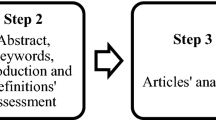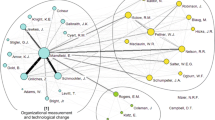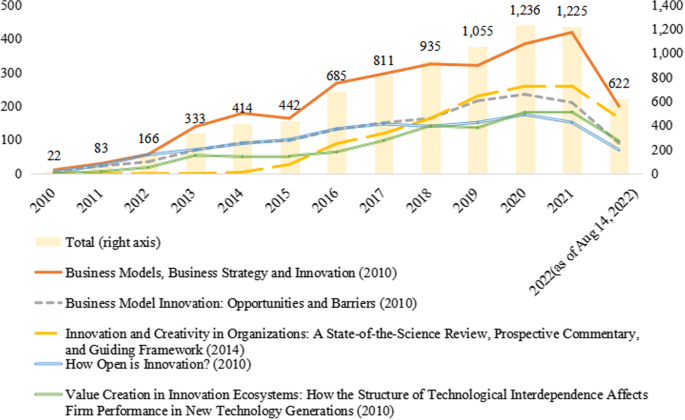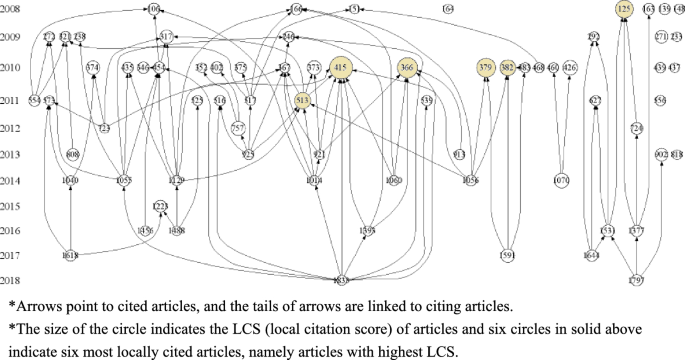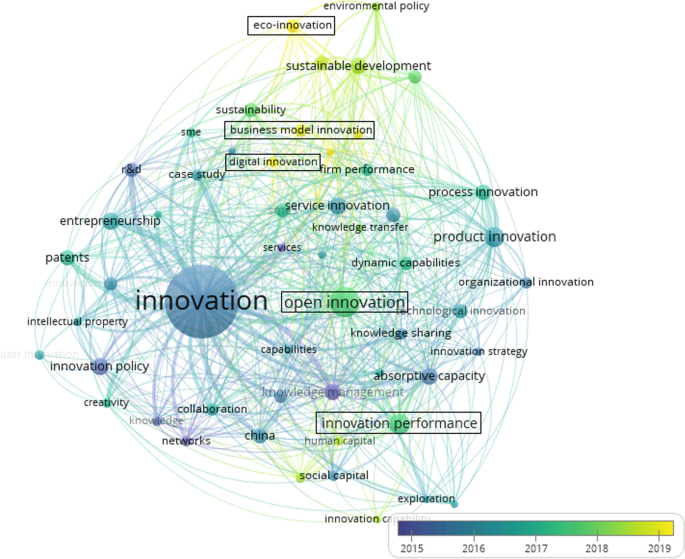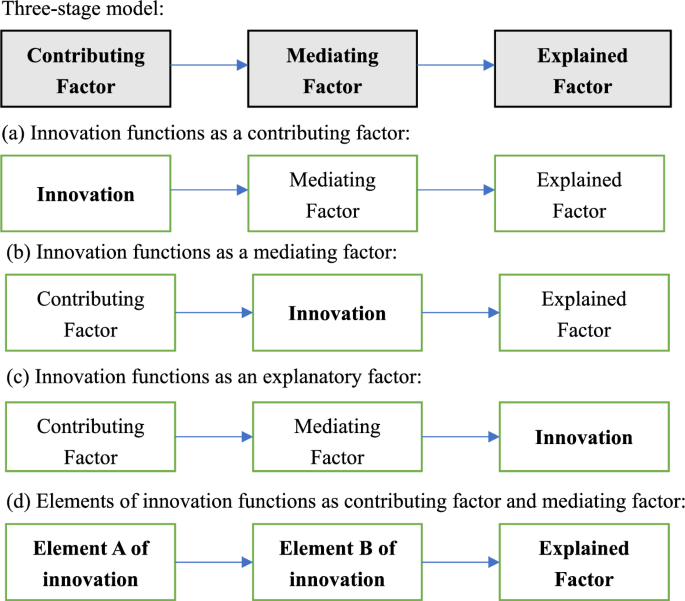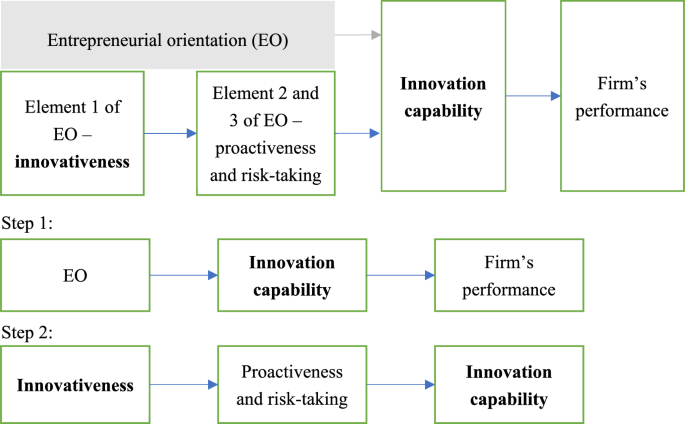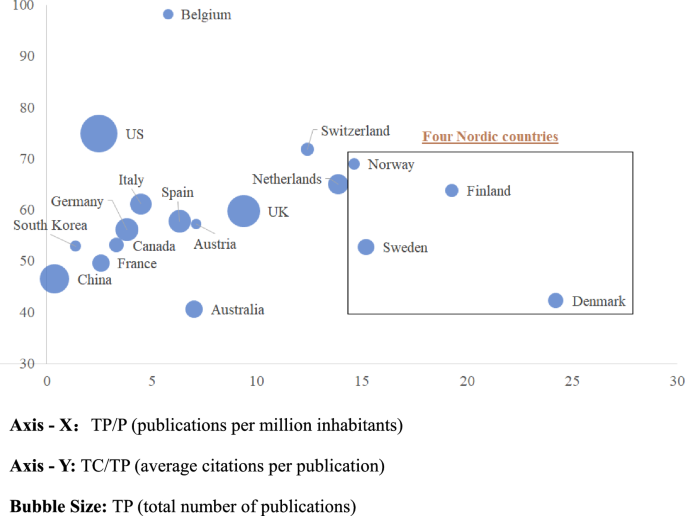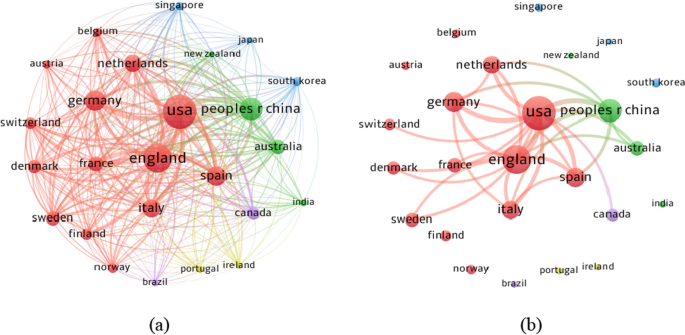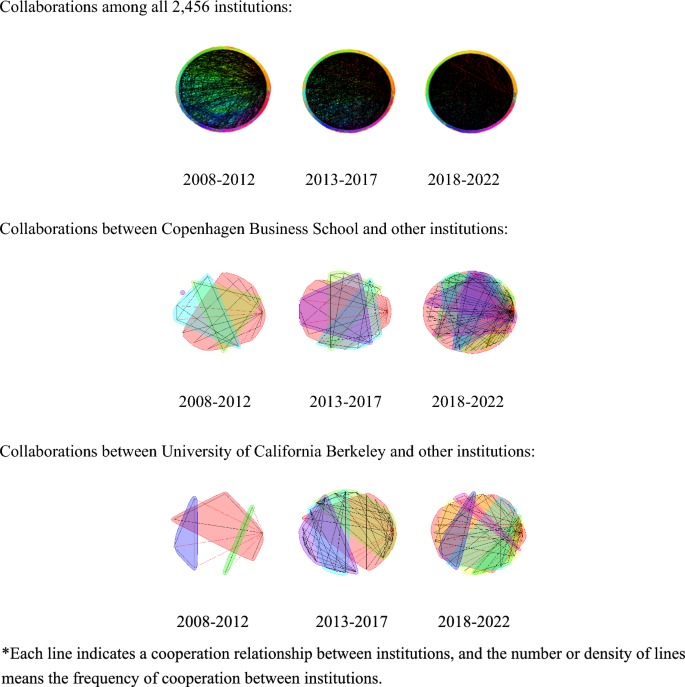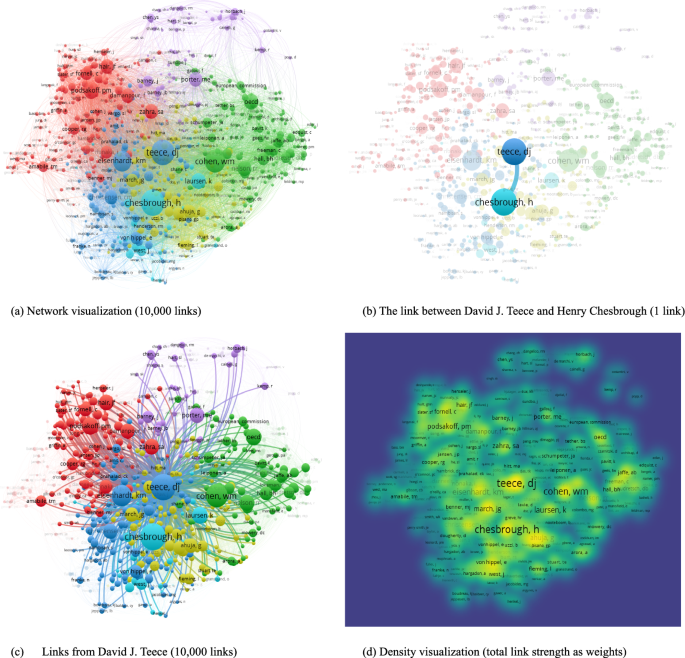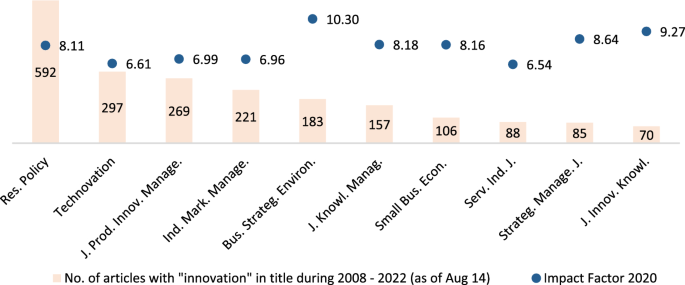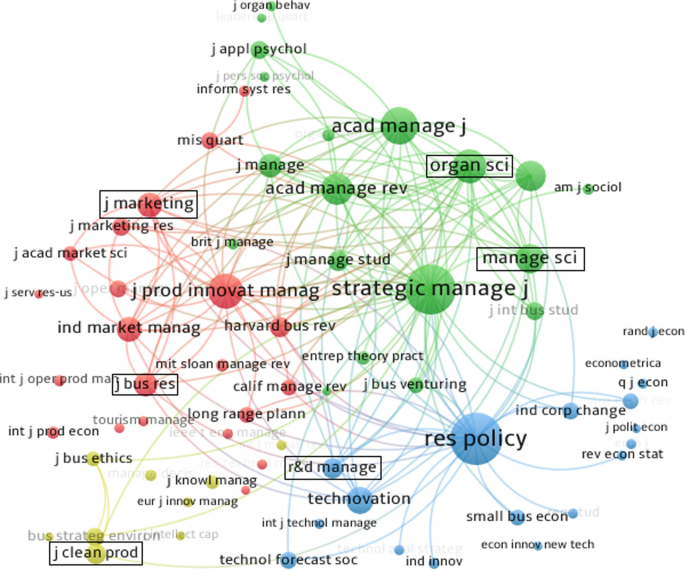Abstract
As the production model transforms from industrial manufacturing to a knowledge-based economy, management innovation becomes a strong driving force for economic growth and social development. This study examines academic findings on management innovation using the latest bibliometric methods and visualization tools based on papers published in top management journals in the Web of Science database from 2008 to 2022. (1) There are three main research hotspots. Through citation orientation, the research hotspots are business model innovation and environmental innovation; through outcome orientation, the research hotspot is knowledge innovation; and through intermediary orientation, the research hotspot is open innovation. (2) Regarding the distribution of major research institutions, seven institutions in the United States focus on innovation research and have a high impact. Six institutions in the United Kingdom focus on innovation research. Meanwhile, nine and three related institutions in Europe and Asia focus on innovation research, respectively. (3) Distribution of innovation articles in journals, Research Policy, Technovation, Journal of Product Innovation Management, and Industrial Marketing Management, contains the largest number of innovation research articles. Furthermore, this study examines new hot topics with time change and digital innovation. This paper provides the latest overview of innovation research in management and discusses the evolution and development of this field.
Similar content being viewed by others
Avoid common mistakes on your manuscript.
1 Introduction and literature review
In the Management Domain, research on innovation, which focuses on the introduction, invention, and implementation of new devices, materials, management practices, processes, structures, and techniques for application to commercial or practical objectives, continues to grow. As many countries move away from an industrial model of production towards a knowledge economy, innovation plays a vital role in economic growth (Xie et al. 2020) and social development (Abhari and Mcguckin 2022). Understanding the status quo and evolution of innovation research supports managers in making better decisions regarding innovation policies.
The term “innovation” was first mentioned in Joseph Schumpeter’s book The Theory of Economic Development in 1912, when Schumpeter, an Austrian-American economist, referred to the third element of economic development as technological innovation or “innovation”, and defined innovation as a change in the existing production system introduced by the entrepreneur to make profits and reduce costs; according to Schumpeter, innovation includes five main cases: new products, new methods of production, new markets, new resources of raw materials, and new organisations. (Schumpeter 1912, 1934).
However, the innovation topic did not receive much attention in the early twentieth century when the present social sciences were emerging. It is not until around the time of the Second World War, when policy makers became interested in R&D, that more attention was paid to innovation studies, since innovation functioned as a vital driving force for progress in the army (Fagerberg et al. 2012). Research on innovation began to flourish in the mid-1960s, when researchers in economics, management, and sociology become interested in the innovation and diffusion of technology (Fagerberg et al. 2011).
Academic interest in innovation research has grown rapidly since the 1990s (Fagerberg and Versoagen 2009). Cohen Wesley and Daniel Levinthal provided a new perspective on innovation through proposing the Absorptive Capacity Theory, which stressed the ability of a firm to assimilate new information (Cohen and Levinthal 1989, 1990). Paul Romer integrated technological innovations into long-run macroeconomic analysis and developed endogenous growth theory, which has generated major research areas into regulations and policies that encourage new ideas and long-term growth (Romer 1990). Teece and Pisano proposed "dynamic capability theory" and value the firm’s ability to respond to a rapidly changing environment (Teece and Pisano 1994; Teece et al. 1997). According to Nonaka and Takeuchi (1995), the essence of innovation is to re-create the world, and innovation indicates a movement between two types of knowledge, “explicit” knowledge, which is formal, systematic, and shareable, and “tacit” knowledge, which is highly personal, difficult to formalise and, hard to share. Utterback (1994) states that existing organisations must consistently abandon past successes and embrace innovation, even when it undermines their traditional strengths. Christensen (1997) coins the term “disruptive innovation”, which is partly built on Schumpeter’s “creative destruction” and refers to transformation of the target market from high-end consumers to a broader population in need of more affordable products and services. The determinants of innovation can be classified into four broad categories: industry structure, firm characteristics, intra-organizational attributes, and institutional influences (Ahuja et al. 2008).
Innovation is a cross-disciplinary field within the social sciences (Fagerberg et al. 2011) and includes different types, such as product/service innovation, process innovation, marketing innovation, and organisational innovation (Taques et al. 2021). The classical definition of management innovation refers to the primary goal of generating profits for a firm, including business model innovation, social innovation, responsible innovation (Stilgoe et al. 2013; Blok and Lemmens 2015), sustainable innovation (Hao et al. 2022) and green innovation (Schiederig et al. 2012), etc.
“Innovation” in the management domain is a broad topic, and the related literature has grown significantly in recent years. However, to the best of our knowledge, bibliometric review papers on managing innovation are limited, although a large body of literature focuses on certain subfields of innovation, such as digital innovation (Hadjielias et al. 2021; Tang et al. 2023) or green innovation (Yuan and Cao 2022; Wang et al. 2020; Huang et al. 2022).
Literature reviews aim to synthesise and integrate existing literature in a certain field (Rowley and Slack 2004; Kraus et al. 2020a). Bibliometrics, first proposed by Alan Pritchard, quantitatively analysing the growth and development of literature on a topic using mathematical and statistical methods (Pritchard 1969). Since its proposal, this method has been widely applied in various research fields to explore the structure, characteristics, laws, and trends of publications on certain subjects. With the development of software tools, bibliometric reviews have grown significantly in recent years, and various visualised bibliometric tools have been used for bibliometric analyses. The mapping software tool VOSviewer provides intuitive bibliometric maps of authors, institutions, countries, literature, and keywords (Van Eck and Waltman 2010). The statistical software tool HistCite, developed by Garfield in 2001, is used less frequently than VOSviewer (Pan et al. 2018). HistCite can generate “chronological maps of subject (topical) collections resulting from searches of the ISI Web of Science” (Garfield 2004). It can display a clear structure of the citation network in chronological order, and clearly discover key documents and general developments in the citation network (Garfield 2009). Bibliometrix is an R-tool for comprehensive science mapping analysis (Aria and Cuccurullo 2017) that can be used for collaboration maps to explore the collaboration relationships between different parties.
Although there is a bibliometric review of the literature on innovation research in the management domain, the existing literature is usually concentrated on sub-fields of innovation, rather than on innovation itself. To our knowledge, no bibliometric review has focused on innovation in the management domain. To fill this research gap, this study, which is based on bibliometric methods (e.g., co-citation analysis, co-occurrence analysis, and bibliographic coupling), visualisation tools (e.g., VOSviewer, HistCite and Bibliometrix), and an online version of Social Sciences Citation Index (SSCI) from the Web of Science database, conducted quantitative and qualitative analyses in terms of countries, institutions, authors, and topics on 3149 “innovation” themed articles published in 56 SSCI Q1 Management journals during 2008–2022 (as of 08/14/2022).
This study is the first attempt to offer a broad and state-of-the-art overview or synthesis of innovation research within the past 15 years in the Management Domain and offers a literature reference for the evolution and development of the field. To achieve these goals, we collected 3149 articles with “innovation” in the title from journals classified as Q1 under Management category by Journal Citation Reports (JCR) and carried out the analysis from aspects of topics, institutions, authors, and countries.
In the topic analysis section, this study is the first to conduct word frequency analysis of titles instead of the widely adopted keyword analysis in the bibliometric analysis of innovation literature in the management domain, which effectively avoid biased conclusions drawn from keyword analysis generated by bibliometric tools. Word frequency analysis of the title can also reveal the research object and method, whereas keyword analysis can only provide information about the article topic.
Furthermore, concerning research methods, this study summarises four types of three-stage mediating models in innovation research, which can be used to classify papers that adopt various mediating models to explore the complex impact mechanism regarding innovation.
This study aims to provide an up-to-date overview of innovation research in the field of management and to inform the evolution and development of the field. In the literature in this field, research subjects are usually firms or organisations. The widely used research methods include case studies, empirical studies, and mediating factors. Research components such as "performance" and "knowledge (such as knowledge management, knowledge sharing, and knowledge transfer)" are prevalent. In many cases, researchers have examined performance to measure the effects of innovation while investigating knowledge to investigate the impact mechanisms of innovation. In summary, this study provides an overview of the following findings: popular research topics, major research institutions and individuals, and major published journals.
2 Data and methods
2.1 Data source
For the literature search, it is recommended to take literature from major online databases because we can access sufficient literature by searching only online databases. (Kraus et al. 2020a). The Web of Science Core Collection was selected as the data source. As a high-quality digital literature database, Web of Science has been the source for the assessment of scientific output because of its multidisciplinary and international coverage (Vieira and Gomes 2009); it covers publications from a wide range of fields, containing more than 15,000 journals and 50,000,000 papers classified in 251 categories and 151 areas (Merigó and Yang 2017), and is a common tool for retrieving and evaluating publications among academics (Thelwall 2008). The Web of Science (WoS) Core Collection, especially its three classical journal citation indexes, the Science Citation Index Expanded (SCIE), Social Sciences Citation Index (SSCI), and Arts and Humanities Citation Index (A&HCI), are well-known and widely used in academia. Since our research scope is limited to SSCI Management journals, the online database of Social Science Citation Index (SSCI) of Web of Science Core Collection fit our need well.
After studying JCR, we selected 56 journals that were classified as Q1 under the management category and utilised the WoS Social Science Citation Index (SSCI) database (2008–2022) to retrieve data (see Table 1). The basic selection procedure is as follows: From 2008 to 2022 (as of 08/14/2022), 3559 unique bibliographic records with “innovation” in the title were published on the 56 sources and indexed in WoS. These 3559 documents included 3149 articles, 121 review articles, 173 editorial materials, and other items such as book reviews or corrections. In this study, the “innovation” dataset only contains 3149 articles that were written by 6640 unique authors from 2456 organisations and 89 countries. These articles cited 114,988 unique references from 56,238 authors and 32,260 unique sources.
2.2 Research methods
In this bibliometric study, quantitative and qualitative analyses were conducted based on the bibliometric methods of co-citation analysis, co-occurrence analysis, and bibliographic coupling, with the support of three visualised bibliometric tools: VOSviewer, HistCite and Bibliometrix. The advantages of visualised tools and bibliometric methods are as follows: (1) the graphical display of large bibliometric maps of countries, institutions, and co-occurring author keywords displayed by VOSviewer makes it intuitive to trace the relationship between different items (Van Eck and Waltman 2010); (2) the co-cited analysis of sources and cited authors presented by VOSviewer, as well as the local citation score provided by HistCite can provide us with co-citation networks and assist academics in identifying the key sources and key authors to refer to when conducting research in this field.
We also considered the multi-disciplinary nature of innovation topics and screened out key journals inside and outside our 56-journal pool. We adopted per-capita metrics to compare the contributions of different countries (Mas-Tur et al. 2020). In the institutional analysis section, we have added information on university rankings for comparison. We also propose a method of word frequency analysis of article titles to identify the research objects, methods, and topics in the innovation management area.
Meanwhile, to observe the expansion of the scope of cooperation and the evolution of topics in innovation research, we use time-segmented analysis in both sections (Sects. 3.2 and 3.4) and create an indicator named the Average Occurring Year in the topic analysis section (Sect. 3.1). When time-segmented data are incorporated into the topic analysis to show the shift of research topics through time from a dynamic perspective, it also assists researchers in identifying research streams and trends in the innovation management field.
3 Result
3.1 Topic analysis
In this section, we analyse the topics of articles in the field of innovation from four perspectives, global citation score, local citation score, author-keyword, and article titles.
Regarding the number of citations of an article, we believe that Global Citation Score (GCS) can indicate the significance of the article in the entire field of social science research, and LCS can better indicate the importance of the article in the innovation management field. We used the Local Citation Score (LCS) indicator to measure the importance of an article. In addition, we drew chronological maps in HistCite to reveal the citation relationships between innovation articles and source articles. Fig. 1 illustrates the evolution of the citations of the five highly most globally cited articles. It can be found that business model innovation (Chesbrough 2010; Teece 2010) is a hot topic in social science research. A noticeable drop in citations was observed in the year 2022 because the data were accessed on Aug 14, 2022, and it was not possible to analyse the whole year. We then used HistCite to draw chronological maps (Fig. 2) and found six source articles with LCS over 7, as listed in Table 2.
The six articles discuss topics that fall within the fields of open innovation (Dahlander and Dann 2010; Huizingh 2011), knowledge sources (Leiponen and Helfat 2010), business model innovation (Chesbrough 2010; Teece 2010), and environmental innovation (Horbach 2006), illustrating that academics involved in innovation management research over the past 15 years have been of great interest in these topics.
3.1.1 Reference-oriented
We further adopted an author-keyword co-occurrence analysis to understand the distribution and trend of the themes of the 3149 articles. Figure 3 demonstrates that besides “innovation”, the author keywords “open innovation” and “innovation performance” occur most frequently, and “business model innovation”, “Eco-innovation”, and “digital innovation” are relatively novel topics (represented in yellow colour).
However, of the 3149 articles, 565 documents were missing author keywords, and the keyword analysis provided by VOSviewer did not combine similar words. For example, the occurrences of “SME”, “SMEs”, “small and medium-sized enterprises”, “small business”, and “small firms” are calculated separately by VOSviewer, providing inaccurate ranking information about the occurrence frequency of author keywords, which will render to biased conclusions on the popularity of article topics. Therefore, we decide to conduct word and phrase frequency analysis of titles to further explore the topic structure of all the 3149 “innovation” publications. The advantages of using title word frequency analysis are as follows: (1) completeness: each article has a title and all 3149 are included in our analysis; (2) accuracy: we can combine similar words or phrases together during the analysis process, resulting in a more precise conclusion; (3) comprehensiveness: while keywords can only help us explore the topics of the articles, words or phrases in titles can reveal the research objects and research methods as well; and (4) dynamic perspective: time-segmented analysis of word or phrase frequency can help us examine the change in popularity of words and phrases, and discover the trend of different topics in innovation research. (5) frontier: the average occurrence time of words can assist in identifying emerging topics in innovation research.
Table 3 partially exhibits the frequency of effective words and phrases in titles, where “effective” means words such as “the”, “and”, “on”, of, “role”, “impact”, “effects”, “model”, “new” and so on are not taken into consideration. Since “innovation” appears in the titles of all the 3149 articles, it ranks the 1st among all the words and phrases. Besides “innovation”, “firm” is the word with the most occurrences since “firms” or “organisations” are usually the research objects of innovation studies in the management area. Firms cover a variety of industries ranging from manufacturing (Aiello et al. 2021) to financial services (Berman et al. 2022; Li et al. 2022), from health care (Coburn et al. 2021; Robb et al. 2022) to tourism (Puertas Medina et al. 2022). Meanwhile, methods of “case” study or “empirical” research have become increasingly popular in lots of influential scientific works. Therefore, Eisenhardt’s papers which discuss building theories from case-study research (Eisenhardt 1989; Eisenhardt and Graebner 2007), have been widely cited in our innovation articles.
3.1.2 Subject classification
By observing the average occurring time of words and phrases (Table 3), we find three words “digital”, “green” and “ecosystem” with the latest average occurring time, followed by five words “Eco-innovation”, “mediating”, “dynamic capacity”, “sustainable”, and “environmental”. Except for “dynamic capacity”, the frequency proportion (frequency of words in titles divided by the total number of articles) of all other seven words have realised an increase of 300–600 basis points between the period of 2008–2012 and 2018–2022 (as of 08/14/2022). This result is in consonance with our previous findings in keyword co-occurrence analysis, where the “business model innovation”, “Eco-innovation”, “digital innovation”, and “Open innovation” are relatively new topics.
“Business model innovation” is a research stream highly related to the strategy field (Foss and Saebi 2017), and emerging technologies are one of the triggers for business model innovation (Astrom et al. 2022; Guo et al. 2022a). There is no consensus regarding the effect of business model innovation on value creation and firm performance, which varies from firm to firm due to resource differences (Wang et al. 2022). To explore the impact mechanism of business model innovation, Guo et al. (2022a) divided business model innovation into three parts, value proposition, value creation, and value capture innovation, finding that value proposition innovation is positively related to digital start-up performance, whereas value creation and value capture innovation play moderating roles in the relationship (Guo et al. 2022a).
“Eco-innovation”, “green innovation”, or “environmental innovation” is identified as one of the main drivers of environmental and economic success. (Dangelico 2016), and environmental sustainability is regarded as one of the main factors of innovation (Dangelico et al. 2017). To facilitate “Eco-innovation”, regulation functions as one of the key triggers (De Marchi 2012; Berrone et al. 2013; Doran and Ryan 2016), and this point of view is emphasised in many environmental economics literature (Kesidou and Demirel 2012). In many cases, the innovation literature tends to emphasise other key triggers of eco-innovations from the perspectives of supply side factors (e.g. firms' organisational capabilities), demand-side factors (e.g. customer requirements), and corporate social responsibility (CSR) (Kesidou and Demirel 2012; Doran and Ryan 2016). Kraus et al. (2020b) shows that CSR positively relates to green innovation thereby indirectly improving environmental performance. As to "sustainable innovation", a kind of long-term innovation, we think it can be divided into two types. One shares a similar meaning with the above-mentioned “Eco-innovation”, “green innovation”, or “environmental innovation”, which pays attention to the sustainability of resources and the environment in the process of enterprise innovation. The other focuses on the sustainability of firms’ own innovation behaviours and is termed “continuous innovation” in some literature (Guo et al. 2020b; Hao et al. 2022).
“Digital innovation”, the adoption of digital technology during the innovation process (Nambisan et al. 2017), is used interchangeably in the literature with “digital venture”, “digital entrepreneurship”, “digital enterprise”, or “digital business” (Kraus et al. 2019a, b). Although companies from various industries have advocated and carried out digital innovations in recent years, “digital innovation” is a research stream still at a nascent stage (Kraus et al. 2019a, b) and is emerging at a rapid pace with the rapid development of digital infrastructures and technologies.
“Open innovation” has been one of the hottest topics during the past 15 years, since it realised an increase of 400 basis points between 2008 to 2012 and 2018 to 2022 (as of 08/14/2022). The frequency of the phrase “open innovation” ranks closely after some traditional innovation topics, such as technology, services, products, and organisations. Considering that the term was coined by Henry Chesbrough in 2003 and, had a history of 18 years, it has become one of the most popular topics in innovation research. “Open innovation” is implemented through four major dimensions: networks, organisational structures, evaluation processes, and knowledge-management systems (Chiaroni et al. 2011). And for open innovation among SMEs, academics find medium-sized firms have a higher chance of being involved heavily in open innovation than smaller firms (van de Vrande et al. 2009).
3.1.3 Result-oriented
“Performance” and “knowledge” are also among the high frequency words. This makes sense because management research is usually results-oriented, and academics are interested in exploring the impact and effect of innovation by investigating “performance”, including financial performance (Faems et al. 2010). Meanwhile, researchers are interested in exploring the impact mechanism of innovation by studying “knowledge”. External knowledge increases innovative performance (Garriga et al. 2013) and innovation types affects the impact of innovation on organisational performance over time (Damanpour et al. 2009). Since innovation is inseparable from the acquisition, absorption, transformation and application of knowledge, scholars are interested in exploring the operation mechanism of innovation through research on “knowledge management”, “knowledge sharing”, “knowledge transfer” and so on, and are likely to adopt some knowledge-related indicators of innovation, such as “quantity of knowledge sources”, “people engaged in knowledge-intensive activities”, etc., to measure service and manufacturing innovation and assess innovation performance (Taques et al. 2021). According to Zhou and Li (2012), firms with broad knowledge base tend to achieve radical innovation through internal knowledge sharing, while firms with deep knowledge base tend to realise radical innovation through market knowledge acquisition.
3.1.4 Mechanism-oriented
The increasing use of the term “mediating” in article titles reveals a shift in research methods for innovation research. Past research usually focuses on the direct relationship between contributing and explained factors (e.g. the direct relationship between sustainable innovation and firm performance) without revealing the impact mechanism or path of action of their relationship, leaving it as a black box. Current research trends suggest that academics are more interested in the impact mechanism or pathways of action between factors in innovation search, and they usually introduce mediators or mediating factors in their analysis of deep incisive probes. Regarding mediation models in innovation research, we simplify them into a three-stage model and briefly classify them into four types according to the different innovation roles in the models (Fig. 4).
First, innovation is a contributing factor. For example, Rodriguez-Gonzalez et al. (2022) investigated the effects of green strategies and eco-innovation on Mexican automotive industry. They took green strategies and eco-innovation as contributing factors, sustainable supply chains as a mediating variable, and sustainable and financial performance of the Mexican automotive industry as the explained factors; they found a direct positive relationship between contributing factors and explained factors, while the mediating variable only showed a mediating effect on one of the explained factors, sustainable performance.
Second, innovation functions as a mediating factor. Naveed et al. (2022) regarded organisational innovation as a mediator and demonstrated its mediating effect on the positive relationship between organisational culture (contributing factor) and organisational effectiveness (explained factor).
Third, innovation is an explanatory factor. For example, a recent study explored the impact of managerial ties (contributing factors) on inbound and outbound open innovation (explained factors) in France, Malaysia, and the UAE by taking absorptive capability as a mediator and found a positive relationship between managerial ties and outbound open innovation in France and the UAE, where absorptive capacity exerts a mediating effect on the relationship (Naqshbandi and Jasimuddin 2022).
Finally, innovation is disassembled into several components and the different elements of innovation function as contributing and mediating factors. For example, to explore the impact mechanism of business model innovation, Guo et al. (2022a). divided business model innovation into three elements, value proposition, value creation, and value capture innovation, and finding that value proposition is positively associated with digital start-up performance. In their analysis, the value proposition (Element A) takes the role of a contributing factor, value creation and value capture innovation (Element B) exert moderating effects, and firm performance is the explained factor.
Some studies adopted more complicated mediating models to explore the complex impact mechanisms of innovation. In many cases, these complicated mediating models can be separated into two or more three-stage models. For example, Santos-Vijande et al. (2022)’s research on the mechanism of translating entrepreneurial orientation (a contributing factor) into firm performance in terms of customer equity and business growth (explained factors), in which innovation capability is regarded as the mediating factor, results in a three-stage mediating model. However, by dividing entrepreneurial orientation into three elements – innovativeness, proactiveness, and risk-taking–they found a mediating effect of proactiveness and risk taking on the positive relationship innovativeness and innovation capability. Thus, this four-stage model combines the two three-stage mediating models. In this case, innovation functions as the mediator factor in Step 1 (Fig. 5) and both the contributing factor and explained factor in Step 2 (Fig. 5).
3.2 Country and institution analysis
A total of 89 countries were involved in publishing innovation articles in SSCI Q1 management journals from 2008 to 2022 (as of 08/14/2022). Table 4 presents the countries with over 50 innovation publications. The leading country with the most articles (TP) in innovation management is the United States (827), followed by the United Kingdom (631) and China (510). The dominant position of the US in innovation research is revealed by its high production (1st in the TP ranking) and influential output (2nd in the TC/TP ranking). Belgium ranks 1st in the TC/TP ranking, demonstrating its high-quality output.
Countries with larger populations tend to produce more publications, resulting in biased conclusions when using only the total number of publications or citations to compare countries in their contribution or dedication to innovation research. To address this problem, we present the results of publications and citations per million inhabitants (Mas-Tur et al. 2020), as shown in Table 5 and Fig. 6, to compare countries with different population sizes. The countries that are dedicated the most to innovation research per capita are the four Nordic countries, as indicated by the total publications per million inhabitants, with Denmark having the highest number of publications per million inhabitants (TP/P) of 24.2, thus contributing the most per capita, followed by Finland, Sweden, and Norway. However, when this method was adopted to calculate contributions, the US and China ranked 16th and 19th among the 19 listed countries, respectively, owing to their large populations.
Next, to determine the cooperative relationship between countries in innovation research, a bibliometric method of bibliographic coupling was applied. The concept of bibliographic coupling was proposed by Kessler (1963), who found that the more similar the subject or content of papers, the more similar the references contained in them. Therefore, two papers that simultaneously cite a third paper are referred to as coupled papers, and the relationship between them is bibliographic coupling. In our case, the two countries form a relationship of bibliographic coupling when they cite the same paper or article, and, to the same extent, bibliographic coupling can reveal the similarity of countries in innovation research.
Figure 7a presents the bibliographic coupling of the 25 countries with a minimum publication threshold of 30 documents and 300 links. Figure 7a presents five clusters in the bibliographic coupling map. The first cluster is led by the US and the UK and contains four Nordic countries (Denmark, Finland, Sweden, and Norway), seven Western European countries (the Netherlands, Belgium, France, Germany, Switzerland, Italy, and Spain), and Austria. The second cluster was comprising of China, Australia, New Zealand, and India, the two largest developing Asian countries with the highest populations in the world, and two developed countries in Oceania. The third cluster comprises Japan, Singapore, and South Korea; all developed Asian countries. The fourth cluster includes Canada, the largest country in North America, and Brazil, the largest country in South America. The fifth cluster comprises Ireland and Portugal, both located on the east coast of the Atlantic Ocean, whose first official language is not English.
To figure out the country with the widest research range, we present the bibliographic coupling map with 30 links in Fig. 7b. We find that the US has the most links with other countries and is thus the widest research topic in innovation studies. Therefore, we can conclude that the US is not only the most productive and influential country in innovation research but has also conducted the most extensive research in the innovation field.
We are interested in institutions involved in innovation research. A total of 2456 institutes published innovation articles in SSCI Q1 management journals between 2008 to 2022 (as of 08/14/2022). For the institution analysis, we list the 25 most productive and influential institutions with over 30 publications or more than 2000 citations in Table 6. We have below findings: (1) The key institutions are all universities, and universities’ rankings (such as QS Ranking USNEWS Ranking, or ARWU Ranking) are not necessarily linked to their interest, performance, or influence in innovation research; however, top universities, such as Harvard University, Massachusetts Institute of Technology, Stanford University, or the University of Cambridge, are all active participants in innovation research. (2) The key institutions consist of seven US institutions, six UK institutions, nine European institutions and three Asian institutions; US and UK institutions comprise over half of the key institutions. When comparing the six UK institutions with seven US institutions, the UK institutions seem to be more productive, with a higher number of publications, while the US institutions seem to be more influential, with a higher ratio of TC/TP (citations per publication). (3) The most heavyweight institution is the University of California Berkeley, since it has 34 publications and the highest citations (7124), which mainly benefit from two highly cited articles—the 2010 paper by David J. Teece entitled “Business Models, Business Strategy and Innovation” (2794 citations), and the 2010 paper by Chesbrough H entitled “Business Model Innovation: Opportunities and Barriers” (1521 citations). (4) Table 6 also indicates that the Copenhagen Business School, which is in Copenhagen, Denmark, was the most productive institution in 2008 and 2022 and topped the ranking of the total number of publications. Denmark, particularly the Greater Copenhagen region, has long enjoyed a reputation for business innovation and has become recognised as a hotbed of innovation and entrepreneurship. Keld Laursen, the head of the Department of Strategy and Innovation at the Copenhagen Business School, was one of the co-editors of Research Policy, the leading journal in innovation research, from 2014 to 2018.
As for the collaboration situation of the institutions, we adopted a time-segmented analysis and divided 2008–2022 into three periods using bibliometrix, a R-tool for bibliometric analysis. As shown in Fig. 8, the density of lines increased over time, indicating that institutions worked more closely than before. We can draw the same conclusion by looking at institutions individually such as Copenhagen Business School or the University of California Berkley, which also illustrates a closer collaboration over time between institutions.
3.3 Authors analysis
This section explores the general research topics of some key-cited authors in each cluster. When measured in number of total published articles, the most productive author is Federico Frattini (17), an Italian author whose area of expertise is strategic management and innovation, followed by Stephen Roper (16), Henry Chesbrough (15), and Zhongju Liao (14). When measured in term of the number of core publications (CP) where the academics are either the 1st author or the corresponding author, Zhongju Liao from Zhejiang Science Technology University, China, ranks the 1st with 14 articles in 2018 and 2022. Zhongju Liao’s articles focused on environmental innovation or eco-innovation and were published in three journals, Business Strategy and the Environment (9), Corporate Social Responsibility and Environmental Management (4), and the British Journal of Management (1). Compared with other leading authors, Zhongju Liao had a relatively lower ratio of citations per publication. One reason for this is that his 14 papers were published after 2018. Table 7 lists the most productive and influential authors.
Next, we applied the cited authors’ co-citation analysis provided by VOSviewer to determine the key cited authors. When two authors are cited in the same document, they form a co-citation relationship (Small 1973). The closer the two authors are to the co-citation map, the more similar the subject or content of their cited articles. For the authors’ co-citation map, we used a minimum citation threshold of 50. As shown in Fig. 9a, there are six clusters based on our dataset since 2008, and each cluster, to some extent, indicates the research direction in the innovation research area. Table 8 shows the cluster structure of the most cited authors and related publications.
Cluster 1 is led by David J. Teece, who, together with Gary Pisano, first put forward the term "dynamic capability" in 1994 (Teece and Pisano 1994), proposed a strategic framework for dynamic capabilities in 1997, and defined the dynamic capability as the firm’s ability to integrate, build, and reconfigure competencies to address rapidly changing environments and regarded the capabilities as combinations of organisational, functional and technological skills (Teece et al. 1997). Focusing on the resource-based view, Eisenhardt and Martin (2000), thought dynamic capacities were the firm's processes that use resources to match and even create market change and thus are the organisational and strategic routines. When James G March concentrated on a balance between exploration and exploitation in organisational learning (March 1991), the “dynamic capabilities” model stressed the exploration side in the context of changing environments. In the face of COVID-19, Dejardin et al. (2022) examined the dynamic capabilities of small and medium-sized enterprises (SMEs) and found that firms shifted their focus from finding new opportunities before the pandemic to bringing their products to the market during and after the pandemic. They confirmed the positive impact of dynamic capabilities on SMEs performance both before and during COVID-19. Regarding the research methods of dynamic capabilities studies, in the early stages, the studies were purely conceptual; later, the case study method gradually became the research method of dynamic capabilities. This cluster includes topics related to dynamic capabilities and strategic management.
Cluster 2 is led by Henry Chesbrough, who stressed using purposive inflows and outflows to accelerate internal innovation, and expand the markets for external use of innovation, which is coined as “open innovation” (Chesbrough 2003). With the proposal of open innovation, many firms have adopted open search strategies and changed the way they search for ideas from internal search to turning to external sources for help, and firms with “open” search strategy are more likely to use universities as a source of innovation (Laursen and Salter 2004). Laursen and Ammon Salter also find that the open search strategy is curvilinearly related to firm performance, and the cost of the open search strategy should be considered before adopting it (Laursen and Salter 2006). Cluster 2 suggested the research directions based on with the theme of open innovation.
Cluster 3 is led by the third most cited author, Wesley Cohen, a professor of Economics and Management at Duke University and the faculty director of the Fuqua School’s Center for Entrepreneurship and Innovation, with a field of interest in the economics of technological change, R&D, strategy, knowledge management, determinants of innovative activity and performance, and so on. Cohen and Levinthal proposed the Absorptive Capacity Theory, which investigates a firm’s ability to recognise the value of new information, assimilate it, and apply it to commercial ends (Cohen and Levinthal 1989; 1990). Since its proposal in 1990, absorptive capacity has become one of the main topics in the research area of innovation management, and papers published in 1989 and 1990 laid the foundation for later research. Nelson mainly focuses on the study of long-term economic change (Nelson 1982) and has been devoted to a project of the national innovation system (Nelson 1993). Innovation systems are regarded as analytical constructs and are of different types (Bergek et al. 2008), such as national and technological innovation systems (Markard and Truffer 2008), and so on. In conclusion, Cluster 3 focused on searches related to knowledge (absorptive capacity) and innovation systems.
Cluster 4, led by Philip M. Podsakoff, Shaker A. Zahra, Joseph F. Hair, and Fariborz Damanpour, includes studies on innovation (Podsakoff and Organ 1986; Damanpour 1991). Damanpour and Schneider found organisational innovation and management tenure are positively related (Damanpour and Schneider 2006), however, Wu and other academics thought that their relationshipwas U-shaped (Anderson et al. 2014).
Cluster 5 is led by Michael Porter, followed by Yu-Shan Chen and Jens Horbach. The research topics of this cluster focus on environmental and green innovation (Porter and Linde 1995; Chen et al. 2006; Horbach 2006).
Cluster 6 is represented by Gautam Ahuja, who is a professor of management and organisations at Cornell University and has a research focus on innovation, technology commercialisation, inter-firm collaboration, and networks. The research focus of Cluster 6 is concentrated on areas of innovation networks and linkages and the use of interorganizational arrangements such as mergers, acquisitions, and alliances (Ahuja 2000). Networking is an effective way for SMEs to facilitate open innovations (Lee et al. 2010). Inter-firm cooperation, when compared to cooperation with intermediaries, research organisations, and governments, has the most significant positive impact on the innovation performance of SMEs (Zeng et al. 2010). Collaboration with research organisations results in advantages in search outcomes (Fabrizio 2009), and coopetition between giants provides advanced technological development (Gnyawali and Park 2011).
Two closely located clusters can be strongly related regarding citations (van Eck and Waltman 2017), indicating a common research interest. In our case, authors from different clusters may have had overlapping research interests, making the classification of clusters less accurate. For example, authors who merge search into knowledge management, absorptive capacity, and dynamic capabilities to arrive at an integrative perspective (Lichtenthaler and Lichtenthaler 2009) can easily fall into Cluster 1 (dynamic capabilities and innovation strategies) or Cluster 3 (absorptive capacity and innovation system). Authors who apply entrepreneurial orientation in the vertical alliance, and discuss product innovation from the perspective of dynamic capabilities can fall into Cluster 1 (dynamic capabilities and innovation strategies) or Cluster 6 (network and linkages) (Bouncken et al. 2016).
Figure 9b indicates that among over 50,000 cited authors, Henry Chesbrough and David J. Teece are closely related. It makes sense for the following reasons: David J. Teece is the director of the Center on Intellectual Capital at Berkeley Haas, while Henry Chesbrough is the executive director of the Center for Corporate Innovation at Berkeley Haas. They are professors at UC Berkeley and share the same research interests of innovation, innovation strategy, technology management, intellectual property, business development, etc.
Figure 9c shows the links from Teece, and Fig. 9d shows the density visualisation of the co-citation map provided by VOSviewer. From Fig. 9c and d, we conclude that David J. Teece functions as the core author linked to other clusters and has the most extensive links with other authors. This makes sense since because Teece has the expertise and research interests in various innovation-related topics such as strategy management, intellectual capital management, intellectual property, technology, dynamic capabilities, and business model innovation. He is very productive and is the author of over 200 books and articles as well as the co-editor of Industrial and Corporate Change.
In conclusion, in our cited-author analysis, we find David J. Teece, Henry Chesbrough, and Wesley Cohen, who has put forward “dynamic capability”, “open innovation” and “absorptive ability”, respectively, are the most cited authors in our innovation articles. They are all US institutions and their influential status indicates their leading positions of US institutions in innovation management research.
3.4 Journal analysis
Table 2 displays the number of innovation articles published in SSCI Q1 management journals each year and the citation structure of these articles (i.e. the number of publications with different citations). The first paper to mention citation counts as a way to measure the popularity and importance of publications was published by Gross and Gross in 1927 (Bornmann and Daniel 2008). Although papers may be cited for various reasons, both scientific and non-scientific (Bornmann and Daniel 2008; Tahamtan and Bornmann 2019), citation counts have become a common method for evaluating scientific performance.
From Table 9, we find that: (1) the number of publications presents an upward trend from 2008 to 2021; (2) articles published in 2010 have the highest average citation counts (total citations/total publications), and the total number of citations increased substantially from 14,828 in 2009 to 24,081 in 2010; and (3) since 2014, the total number of citations has been decreasing each year.
The increasing trend in article numbers suggests that academics and researchers have paid more attention to innovation topic in management over the past 15 years. Many highly cited articles were published in 2010, resulting in a higher average citation count than in other years. In 2010, there were four articles with more than 1000 citations, and nine articles with more than 500 citations, whereas in other years, there was at most one article with more than 1000 times and four with over 500 citations. Finally, the possible reasons for the decline in total citations since 2014 are mainly of two aspects: (1) newly published articles have not yet been exposed to a large number of academics, researchers, or audiences and have not been widely cited, affecting their citation counts; (2) it takes a long time for newly submitted articles citing these papers to go through the review process before publication.
All innovation articles were retrieved from SSCI Q1 management journals. We will (1) further explore and find core journals in innovation management areas and (2) find journals outside our 56-journal pool, which also serve as key journals for innovation research.
For task (1), we checked the number of innovation articles published in 56 journals and introduced the local citation score provided by HistCite to identify core journals further. Figure 10 manifests the top 10 journals with the most “innovation” articles during 2008 to 2022 (as of 08/14/2022) and the impact factor of those journals. Most of the 10 journals are cross-disciplinary management journals that cover fields of management and other areas, such as business, economics, planning and development, the engineering industry, operations research and management science, and information science and library science. The total number of articles published in the 10 journals was 2068, which constituted 66% of the 3149 retrieved “innovation” articles. In terms of the number of articles, the top four management journals in innovation research are Research Policy (592), Technovation (297), Journal of Product Innovation Management (269), and Industrial Marketing Management (221).
Table 10 lists the 21 most locally cited journals among the 56 journals according to the results found in HistCite. The LCS stands for the Local Citation Score and is the number of times a paper is cited by other papers in the local collection, whereas the GCS stands for the Global Citation Score and shows the citation frequency based on the total count in the Web of Science (Garfield 2009). Twenty-one journals were identified, using LCS = 100 as the minimum threshold. Except for the top four journals mentioned above, mainstream strategic management journals such as Business Strategy and the Environment, Strategic Management Journal, Long Range Planning, and Journal of Knowledge Management are also greatly influential innovation research because these four journals have both high LCS and GCS values. With the continuous advancement of innovative research in the field of strategic management, strategic management journals serve as important sources for researchers on this topic. Business Strategy and the Environment is a journal that covers environmental studies, including innovation research in the field of environmental management and sustainable development.
Last, it can be seen From Table 10 that the LCS, GCS and publications numbers of Research Policy (2971, 45923, 592, respectively) are far beyond other journals. There is no doubt that Research Policy is one of the oldest and best-known journals in the field of innovation studies (Fagerberg et al. 2011), it is a multi-disciplinary journal devoted to the economic, policy, management, organisational, environmental, and other challenges posed by innovation, technology, R&D, and science, and is widely regarded as the leading journal in the innovation field (Fagerberg and Verspagen 2009).
The task 2 is accomplished in two steps. First, we searched for the most significant referent journals or sources outside our 56-journal pool and then identified the journals outside our 56-journal pool that have been impacted by our innovation articles the most.
First, we apply a cited-source co-citation analysis provided by VOSviewer to determine the key cited sources outside our journal pool. Cocitation analysis was first proposed by Small in 1973 as a research method for measuring the degree of relationship between documents. When two documents are cited by the same third document, they constitute a co-citation relationship (Small 1973). VOSviewer helps construct journal co-citation maps and identity clusters of related items (van Eck and Waltman 2010). Four clusters were identified (Fig. 11). The first cluster was led by Research Policy, Technovation, and out-of-pool journal R&D Management. The second cluster consists of Strategic Management Journal, Academy of Management Journal, Academy of Management Review, and two out-of-pool journals, Organization Science and Management Science. The third cluster is led by Journal of Product Innovation Management, Industrial Marketing Management and two out-of-pool journals, Journal of Marketing and Journal of Business Research. The fourth was led by an out-of-pool journal the Journal of Cleaner Production. And there are five main research areas cited by our 3149 innovation articles: management, business, economics, technology, and environmental sciences. In conclusion, the key out-of-pool journals are as follows: (1) Organization Science (under SSCI Management Q2), (2) Management Science (under SSCI Management Q2), (3) R&D Management (under SSCI Management Q2 and Business Q3), (4) Journal of Marketing (under SSCI Business Q1), (5) Journal of Business Research (under SSCI Business Q1), and (6) Journal of Cleaner Production (under SSCI Engineering Environmental Q1).
Next, we list journals that have published more than 500 articles, citing our 3149 innovation articles from the Web of Science database as shown in Table 11, to explore the influence of innovation articles on out-of-pool journals. As Table 11 shows, the top four journals with the most publications citing our “innovation” articles are all out-of-pool journals from the area of environmental science, business, or engineering environmental. The journal with most publications citing our innovation articles was Sustainability, an environmental science journal covering climate science, sustainability programs and new collaborations. Other key out-of-pool journals include Technological Forecasting and Social Change, Journal of Business Research, Journal of Cleaner Production, Technology Analysis Strategic Management, and Frontiers in Psychology. On the one hand, it demonstrates that innovation is an interdisciplinary research field: for example, innovation is related to psychology for many reasons. One study reveals that learning from innovation failures is a complicated mechanism that depends on various factors, especially those related to individual psychology (Rhaiem and Amara 2021); On the other hand, it illustrates the influence and reference role of our journals on other out-of-pool journals.
4 Conclusion and future research
4.1 Conclusions
No bibliometric review has focused on innovation itself in the management domain. To fill in the research gap, in this study, we selected 3149 articles with “innovation” in titles and with publication dates falling between 2008 and 2022 (as of 08/14/2022) from 56 SSCI Q1 Management journals with the purpose of offering a state-of-the-art overview of the innovation research in the Management domain and offering a reference for the evolution and development of the field.
To achieve our goal, we adopted various bibliometric methods, such as co-citation, co-occurrence and bibliographic coupling analyses, and took advantage of different visualisation tools, such as, VOSviewer, HistCite and bibliometrix. We conducted quantitative and qualitative analysis from aspects of journals, countries, institutions, authors, cited authors and topics on 3149 “innovation” articles.
For our conclusions, we find in this research area: (1) research objects are usually firms or organisations; (2) widely adopted research methods include case studies, empirical research, mediating factor, etc.; (3) Academics are especially interested in investigating into contents of “performance” and “knowledge (e.g., knowledge management, knowledge sharing and knowledge transfer)”, and in many cases, while researchers study performance to measure the effect of innovation, they study knowledge to investigate the impact mechanism of innovation; (4) “open innovation”, as a sub-field of innovation, has become one of the hottest topics in innovation studies since its proposal in 2003, while “green innovation” (or “Eco-innovation”) and “digital innovation” indicate new trends of this research area.
4.2 Main contribution
The main contributions of this article lie in the following aspects.
The first aspect is the innovation of the methods. The word frequency analysis, time-segmented analysis and the average occurrence time of word analysis adopted in Sect. 3.4 can overcome the shortcomings of bibliometric tools and help us reveal the research objects and research methods as well as topics and discover the research trends in innovation studies. This study is the first to conduct title word frequency analysis instead of the widely adopted keyword analysis in the bibliometric analysis of innovation literature in the management domain. This effectively avoids biased conclusions drawn from keyword analysis generated by bibliometric tools.
The second aspect is the originality of the categorisation of mediating models adopted in innovation research. We not only point out the research trends of adopting mediating factors to investigate impact mechanisms in innovation research but also simplify the mediating models into a three-stage model and briefly summarise them into four types according to the different roles of innovation in the models, which can be used to classify papers adopting various mediating models to explore the complex impact mechanism regarding innovation.
The third aspect is the location of core journals by exploring cross-references. In the journal analysis part (Sect. 3.1), taking into account the interdisciplinary nature of the topic of innovation, we not only screened out core journals from our pool of 56 journals but also screened out the potential journals outside the pool based on references of 3149 “innovation” articles and journals that have cited our “innovation” articles. These journals are closely related to our innovation management topics and may provide effective and efficient references for scholars and researchers in their studies. The top four journals with the most publications citing our “innovation” articles are all out-of-pool journals from the area of environmental science, business, or engineering environmental. On the one hand, it demonstrates that innovation is an interdisciplinary research field; on the other hand, it illustrates the influence and reference role of our journals on other out-of-pool journals.
The fourth aspect is the combination of bibliometric tools. Three bibliometric tools were used for the analysis. VOSviewer is a strong tool for generating maps; therefore, we used it for co-citation maps, bibliographic coupling maps, and other maps. HistCite provides us with a local citation score (LCS) for each document and can generate chronological maps that display clear structure of the citation network in chronological order, so we use HistCite to locate the source articles within our “innovation” publications. We use bibliometrix, an R-tool, to draw collaboration networks and observe the development of institutions’ collaborations over time.
4.3 Limitations and future research
This study has some limitations. First when retrieving the literature for analysis, we choose “innovation” or “innovations” as query keywords. Though there are reasonable reasons behind this choice, innovation literature without “innovation” or “innovations” in the title is ignored, and this may render to biased research conclusions of this paper. Second, although online databases have made access to the literature much easier than before, it is still time-consuming to discover the required literature. Finally, although innovation is a cross-disciplinary topic, this study does not provide an in-depth analysis of the development of innovation studies in social science fields other than management domain.
Future research directions on bibliometric review papers on innovation are as follows: First, in the future, we expect to conduct further research on innovation in different domains, such as economics, compare their differences in research objects, research methods, and research contents, determine the development of innovation studies in different domains, and reveal their relations. Moreover, with continuous technical innovations and breakthroughs, we expect to create bibliometric reviews in this research field with the support of algorithms (Kraus et al. 2020a), which can help us identify keywords and search strings more precisely, and help discover and screen out the exact literature on a certain topic needed for bibliometric analysis.
References
Abhari K, Mcguckin S (2022). Limiting factors of open innovation organizations: a case of social product development and research agenda. Technovation
Ahuja G (2000) Collaboration networks, structural holes, and innovation: a longitudinal study. Adm Sci Q 45(3):425–455
Ahuja G, Lampert CM, Tandon V (2008) Moving beyond Schumpeter: management research on the determinants of technological innovation. Acad Manag Ann 2(1):1–98
Aiello F, Cardamone P, Mannarino L, Pupo V (2021) Does external R&D matter for family firm innovation? Evidence from the Italian manufacturing industry. Small Bus Econ 57(4):1915–1930
Anderson N, Potocnik K, Zhou J (2014) Innovation and creativity in organizations: a state-of-the-science review, prospective commentary, and guiding framework. J Manag 40(5):1297–1333
Aria M, Cuccurullo C (2017) Bibliometrix: An R-tool for comprehensive science mapping analysis. J Informet 11(4):959–975
Astrom J, Reim W, Parida V (2022) Value creation and value capture for AI business model innovation: a three-phase process framework. Rev Manag Sci. Early Access
Bergek A, Jacobsson S, Carlsson B, Lindmark S, Rickne A (2008) Analyzing the functional dynamics of technological innovation systems: a scheme of analysis. Res Policy 37(3):407–429
Berman A, Cano-Kollmann M, Mudambi R (2022) Innovation and entrepreneurial ecosystems: fintech in the financial services industry. RMS 16(1):45–64
Berrone P, Fosfuri A, Gelabert L, Gomez-Mejia LR (2013) Necessity as the mother of ‘green’ inventions: institutional pressures and environmental innovations. Strateg Manag J 34(8):891–909
Blok V, Lemmens P (2015) The emerging concept of responsible innovation: three reasons why it is questionable and calls for a radical transformation of the concept of innovation. Responsible Innovation 2: concepts, approaches, and applications. Springer International Publishing. ISBN: 9783319173085
Bornmann L, Daniel HD (2008) What do citation counts measure? A review of studies on citing behavior. J Document 64(1):45–80
Bouncken RB, Pluschke BD, Pesch R, Kraus S (2016) Entrepreneurial orientation in vertical alliances: joint product innovation and learning from allies. RMS 10(2):381–409
Chen YS, Lai SB, Wen CT (2006) The influence of green innovation performance on corporate advantage in Taiwan. J Bus Ethics 67(4):331–339
Chesbrough H (2003) Open innovation: the new imperative for creating and profiting from technology. Harvard Business School Press, Cambridge, MA
Chesbrough H (2010) Business model innovation: opportunities and barriers. Long Range Plan 43(2–3):354–363
Chiaroni D, Chiesa V, Frattini F (2011) The open innovation journey: how firms dynamically implement the emerging innovation management paradigm. Technovation 31(1):34–43
Christensen C (1997) The innovator’s dilemma. Harvard Business School Press, Cambridge, MA
Coburn J, Bone F, Hopkins MM, Stirling A, Mestre-Ferrandiz J, Arapostathis S, Llewelyn MJ (2021) Appraising research policy instrument mixes: a multicriteria mapping study in six European countries of diagnostic innovation to manage antimicrobial resistance. Res Policy 50(4)
Cohen WM, Levinthal DA (1989) Innovation and learning: the two faces of R & D. Econ J 99(397):569–596
Cohen WM, Levinthal DA (1990) Absorptive capacity: a new perspective on learning and innovation. Adm Sci Q 35(1):128–152
Dahlander L, Gann DM (2010) How open is innovation. Res Policy 39(6):699–709
Damanpour F (1991) Organizational innovation: a meta-analysis of effects of determinants and moderators. Acad Manag J 34(3):555–590
Damanpour F, Schneider M (2006) Phases of the adoption of innovation in organizations: effects of environment, organization and top managers. Br J Manag 17:215–236
Damanpour F, Walker RM, Avellaneda CN (2009) Combinative effects of innovation types and organizational performance: a longitudinal study of service organizations. J Manage Stud 46(4):650–675
Dangelico RM (2016) Green product innovation: where we are and where we are going. Bus Strateg Environ 25(8):560–576
Dangelico RM, Pujari D, Pontrandolfo P (2017) Green product innovation in manufacturing firms: a sustainability-oriented dynamic capability perspective. Bus Strateg Environ 26(4):490–506
De Marchi V (2012) Environmental innovation and R&D cooperation: empirical evidence from Spanish manufacturing firms. Res Policy 41(3):614–623
Dejardin M, Raposo ML, Ferreira JJ, Fernandes CI, Veiga PM, Farinha L (2022) The impact of dynamic capabilities on SME performance during COVID-19. Rev Manag Sci. Early Access
Doran J, Ryan G (2016) The importance of the diverse drivers and types of environmental innovation for firm performance. Bus Strateg Environ 25(2):102–119
Du JS, Leten B, Vanhaverbeke W (2014) Managing open innovation projects with science-based and market-based partners. Res Policy 43(5):828–840
Eisenhardt KM (1989) Building theories from case study research. Acad Manag Rev 14(4):532–550
Eisenhardt KM, Graebner ME (2007) Theory building from cases: opportunities and challenges. Acad Manag J 50(1):25–32
Eisenhardt KM, Martin JA (2000) Dynamic capabilities. What are they? Strateg Manag J 21:1105–1121
Fabrizio KR (2009) Absorptive capacity and the search for innovation. Res Policy 38(2):255–267
Faems D, de Visser M, Andries P, Van Looy B (2010) Technology alliance portfolios and financial performance: value-enhancing and cost-increasing effects of open innovation. J Prod Innov Manag 27(6):785–796
Fagerberg J, Versoagen B (2009) Innovation studies – the emerging structure of a new scientific field. Res Policy 38(7):218–233
Fagerberg J, Fosaas M, Bell M, Martin BR (2011) Christopher Freeman: social science entrepreneur. Res Policy 40(7):897–916
Fagerberg J, Fosaas M, Sapprasert K (2012) Innovation: exploring the knowledge base. Res Policy 41(7):1132–1153
Foss NJ, Saebi T (2017) Fifteen years of research on business model innovation: how far have we come, and where should we go. J Manag 43(1):200–227
Garfield E (2004) Historiographic mapping of knowledge domains literature. J Inf Sci 30(2):119–145
Garfield E (2009) From the science of science to Scientometrics visualizing the history of science with HistCite software. J Informet 3(3):173–179
Garriga H, von Krogh G, Spaeth S (2013) How constraints and knowledge impact open innovation. Strateg Manag J 34(9):1134–1144
Gnyawali DR, Park BJ (2011) Co-opetition between giants: collaboration with competitors for technological innovation. Res Policy 40(5):650–663
Guo H, Guo A, Ma H (2022a) Inside the black box: how business model innovation contributes to digital start-up performance. J Innov Knowl 7(2):100188
Guo J, Cui L, Sun SL, Zou B (2022b) How to innovate continuously? Conceptualizing generative capability. J Innov Knowl 7(2):100177
Hadjielias E, Dada O, Cruz AF, Zekas S, Christofi M, Sakka G (2021) How do digital innovation teams’ function? Understanding the team cognition-process nexus within the context of digital transformation. J Bus Res 122:373–386
Hao Z, Zhang X, Wei J (2022) Research on the effect of enterprise financial flexibility on sustainable innovation. J Innov Knowl 7(2):100184
Horbach J (2006) Determinants of environmental innovation - new evidence from German panel data sources. Res Policy 37(1):163–173
Huang L, Wang C, Chin T, Huang J, Cheng X (2022). Technological knowledge coupling and green innovation in manufacturing firms: moderating roles of mimetic pressure and environmental identity. Int J Prod Econ
Huizingh EKRE (2011) Open innovation: state of the art and future perspectives. Technovation 31(1):2–9
Kesidou E, Demirel P (2012) On the drivers of eco-innovations: empirical evidence from the UK. Res Policy 41(5):862–870
Kessler MM (1963) Bibliographic coupling between scientific papers. Am Doc 14(1):10–25
Kraus S, Palmer C, Kailer N, Kallinger FL, Spitzer J (2019a) Digital entrepreneurship - a research agenda on new business models for the twenty-first century. Int J Entrep Behav Res 25(2):353–375
Kraus S, Roig-Tierno N, Bouncken RB (2019b) Digital innovation and venturing - an introduction into the digitalization of entrepreneurship. RMS 13(3):519–528
Kraus S, Breier M, Dasí-Rodríguez S (2020a) The art of crafting a systematic literature review in entrepreneurship research. Int Entrep Manag J 16:102–1042
Kraus S, Rehman SU, Garcia FJS (2020b) Corporate social responsibility and environmental performance: the mediating role of environmental strategy and green innovation. Technol Forecast Soc Change 160
Laursen K, Salter A (2004) Searching high and low: what types of firms use universities as a source of innovation? Res Policy 33(8):1201–1215
Laursen K, Salter A (2006) Open for innovation: the role of openness in explaining innovation performance among UK manufacturing firms. Strateg Manag J 27(2):131–150
Lee S, Park G, Yoon B, Park J (2010) Open innovation in SMEs—An intermediated network model. Res Policy 39(2):290–300
Leiponen A, Helfat CE (2010) Innovation objectives, knowledge sources, and the benefits of breadth. Strateg Manag J 31(2):224–236
Li CM, He S, Tian Y, Sun SQ, Ning L (2022) Does the bank’s FinTech innovation reduce its risk-taking? Evidence from China’s banking industry. J Innov Knowl 7(3):100219
Lichtenthaler U, Lichtenthaler E (2009) A capability-based framework for open innovation: complementing absorptive capacity. J Manage Stud 46(8):1315–1338
March JG (1991) Exploration and exploitation in organisational learning. Org Sci 2(1):71–87
Markard J, Truffer B (2008) Technological innovation systems and the multi-level perspective: towards an integrated framework. Res Policy 37(4):596–615
Mas-Tur A, Kraus S, Brandtner M, Ewert R, Kursten W (2020) Advances in management research: a bibliometric overview of the review of managerial science. RMS 14:933–958
Merigó JM, Yang JB (2017) A bibliometric analysis of operations research and management science. Omega 73:37–48
Nambisan S, Lyytinen K, Majchrzak A, Song M (2017) Digital innovation management: reinventing innovation management research in a digital world. MIS Q 41(1):223–238
Naqshbandi MM, Jasimuddin SM (2022) The linkage between open innovation, absorptive capacity and managerial ties: a cross-country perspective. J Innov Knowl 7(2):100167
Naveed RT, Alhaidan H, Halbusi HA, Al-Swidi AK (2022) Do organizations really evolve? The critical link between organizational culture and organizational innovation toward organizational effectiveness: pivotal role of organizational resistance. J Innov Knowl 7(2):100178
Nelson RR (1993) National innovation systems: a comparative analysis. Oxford University Press, New York
Nelson RR, Winter SG (1982) An evolutionary theory of economic change. Harvard University Press, Cambridge
Nonaka I, Takeuchi H (1995) The knowledge creating company: how Japanese companies create the dynamics of innovation. Oxford University Press, New York
Pan X, Yan E, Cui M, Hua W (2018) Examining the usage, citation, and diffusion patterns of bibliometric mapping software: a comparative study of three tools. J Informet 12(2):481–493
Podsakoff PM, Organ DW (1986) Self-reports in organizational research problems and prospects. J Manag 12(4):531–544
Porter ME, Linde C (1995) Toward a new conception of the environment-competitiveness relationship. J Econ Perspect 9(4):97–118
Pritchard A (1969) Statistical bibliography or bibliometrics. J Document 25(4):348–349
Puertas Medina RM, Martín Martín JM, Guaita Martínez JM, Serdeira Azevedo P (2022) Analysis of the role of innovation and efficiency in coastal destinations affected by tourism seasonality. J Innov Knowl 7(1):100163
Rhaiem K, Amara N (2021) Learning from innovation failures: a systematic review of the literature and research agenda. RMS 15(2):189–234
Robb A, Rohrschneide M, Booth A, Carter P, Walker R, Andrews G (2022) Enhancing organizational innovation capability-a practice-oriented insight for pharmaceutical companies. Technovation 115
Rodriguez-Gonzalez RM, Maldonado-Guzman G, Madrid-Guijarro A (2022) The effect of green strategies and eco-innovation on Mexican automotive industry sustainable and financial performance: sustainable supply chains as a mediating variable. Corp Soc Responsib Environ Manag 29(4):779–794
Romer PM (1990) Endogenous technical change. J Polit Econ 98(5):71–102
Rowley J, Slack F (2004) Conducting a literature review. Manag Res News 27(6):31–39
Santos-Vijande ML, López-Sánchez JÁ, Loredo E, Rudd J, López-Mielgo N (2022) Role of innovation and architectural marketing capabilities in channeling entrepreneurship into performance. J Innov Knowl 7(2):100174
Schiederig T, Tietze F, Herstatt C (2012) Green innovation in technology and innovation management – an exploratory literature review. R&D Manag 42(2):180–192
Schumpeter JA (1912/1934) The theory of economic development. Harvard Business School Press. Boston, MA
Small H (1973) Cocitation in science literature: new measures of relationship between two documents. J Am Soc Inform Sci Technol 24(4):265–269
Stilgoe J, Owen R, Macnaghten P (2013) Developing a framework for responsible innovation. Res Policy 42(9):1568–1580
Tahamtan I, Bornmann L (2019) What do citation counts measure? An updated review of studies on citations in scientific documents published between 2006 and 2018. Scientometrics 121(3):1635–1684
Tang H, Xie Y, Liu Y, Boadu F (2023). Distributed innovation, knowledge re-orchestration, and digital product innovation performance: the moderated mediation roles of intellectual property protection and knowledge exchange activities. J Knowl Manag
Taques FH, López MG, Basso LF, Areal N (2021) Indicators used to measure service innovation and manufacturing innovation. J Innov Knowl 6(1):11–26
Teece DJ (2010) Business models, business strategy and innovation. Long Range Plan 43(2–3):172–194
Teece DJ, Pisano G (1994) The dynamic capabilities of firms: An Introduction. Ind Corp Chang 3(3):537–556
Teece DJ, Pisano G, Shuen A (1997) Dynamic capabilities and strategic management. Strateg Manag J 18(7):509–533
Thelwall M (2008) Bibliometrics to webometrics. J Inf Sci 34(4):605–621
Utterback J (1994) Mastering the dynamics of innovation. Harvard Business School Press, Boston, MA
Van de Vrande V, de Jong JPJ, Vanhaverbeke W, de Rochemont M (2009) Open innovation in SMEs: trends, motives and management challenges. Technovation 29(6–7):423–437
Van Eck NJ, Waltman L (2010) Software survey: VOSviewer, a computer program of bibliometric mapping. Scientometrics 84(2):523–538
Van Eck NJ, Waltman L (2017) Citation-based clustering of publications using CitNetExplorer and VOSviewer. Scientometrics 111(2):1053–1070
Vieira ES, Gomes J (2009) A comparison of Scopus and Web of Science for a typical university. Scientometrics 81(2):587–600
Wang J, Xue Y, Sun X, Yang J (2020) Green learning orientation, green knowledge acquisition and ambidextrous green innovation. J Clean Prod 250:119475
Wang C, Fang Y, Zhang C (2022) Mechanism and countermeasures of “The Innovator’s Dilemma” in business model. J Innov Knowl 7(2):100169
Xie F, Zhang B, Zhang W (2020). Trust, incomplete contracting, and corporate innovation. ERN: Behavioral Economics (Topic)
Yuan B, Cao X (2022). Do corporate social responsibility practices contribute to green innovation? The mediating role of green dynamic capability. Technol Soc
Zeng SX, Xie XM, Tam CM (2010) Relationship between cooperation networks and innovation performance of SMEs. Technovation 30(3):181–194
Zhou KZ, Li CB (2012) How knowledge affects radical innovation: knowledge base, market knowledge acquisition, and internal knowledge. Strateg Manag J 33(9):1090–1102
Funding
The authors did not receive support from any organization for the submitted work.
Author information
Authors and Affiliations
Corresponding author
Ethics declarations
Conflict of interest
The authors have no financial or proprietary interests in any material discussed in this article.
Additional information
Publisher's Note
Springer Nature remains neutral with regard to jurisdictional claims in published maps and institutional affiliations.
Rights and permissions
Springer Nature or its licensor (e.g. a society or other partner) holds exclusive rights to this article under a publishing agreement with the author(s) or other rightsholder(s); author self-archiving of the accepted manuscript version of this article is solely governed by the terms of such publishing agreement and applicable law.
About this article
Cite this article
Lin, X., Ribeiro-Navarrete, S., Chen, X. et al. Advances in the innovation of management: a bibliometric review. Rev Manag Sci 18, 1557–1595 (2024). https://doi.org/10.1007/s11846-023-00667-4
Received:
Accepted:
Published:
Issue Date:
DOI: https://doi.org/10.1007/s11846-023-00667-4


